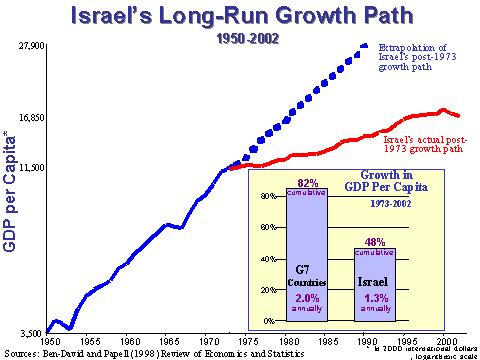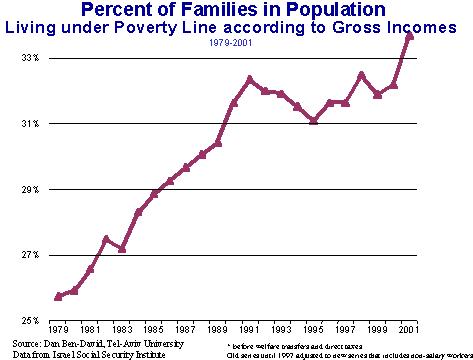The Jerusalem Post, February 5, 2004.
Dan Ben-David Tel-Aviv University The State of Israel is facing a number of serious socio-economic problems that, although they have been substantially exacerbated over the last few years, have in fact been steadily and seriously deteriorating over a period that is not measured in years, but in decades. The catch-words are familiar to all: growth, unemployment, poverty, inequality and welfare payments. What is less known are the dimensions of these problems - and what is particularly disturbing: the extent to which they have deteriorated since the seventies. The turning point was the year 1973. This period was a turning point for many Western countries. The difference between us and them was the degree of the turnaround. While most of the industrialized countries shifted to healthy long-run paths, we moved to multi-decade trajectories that are leading us straight toward a national abyss. How stable are our socio-economic trajectories? They have survived wars, hyper-inflation and massive immigration. In the latter two cases, the scale was beyond anything that the West has known since the Second World War. But all these were simply reflected in gyrations around the long-run trajectories rather than causing changes in trend. The stability of our long-run paths, in spite of all that we have gone through, leads to the impression that these trends are etched in stone and that our fate is not in our hands. Nothing could be more dangerous, or more distant from reality. What do our trajectories leading to the national abyss look like? 1. Growth Israel's output per capita - the common measure used to determine living standards in a country - rose by more than 5% per year between 1950 and 1972, one of the highest growth rates in the world. The income gap between Israel and the leading industrialized countries decreased rapidly. 
Since 1973, everything looks different. As the graph indicates, the steep growth path that reflected the high growth in the years 1950-1972 turned into one of the West's shallowest growth paths. While living standards in the G7 countries rose by 82% between 1973 and 2002, Israel's standard of living rose by just 48%. In other words, instead of continuing to close the income gap with the leading countries, we have been steadily falling behind in relative terms since 1973. The primary key for improving living standards is through technological improvements - that is, through improvements in the qualities of production factors and through improvements in the way that they are utilized. In this area, Israel has a problem. During the past several decades, in spite of the substantial increases in government spending, the country's set of national priorities led to a massive neglect of its physical and human capital infrastructures - which are key ingredients driving technological progress. 2. Unemployment If one excludes the temporary unemployment bubble in the early nineties caused by the huge wave of Soviet immigration into Israel, the figure indicates steadily increasing rates of unemployment from 1973 until today. The main problem, which is continuously worsening, is among the unskilled and least educated working-age population. A modern, open and competitive economy needs more and more educated and skilled workers - and relatively less unskilled and poorly educated. While this is a problem faced by all industrialized countries, it is particularly acute in Israel. As though the declining relative demand for unskilled workers wasn't enough, Israel has been importing hundreds of thousands of these types of workers from abroad and exacerbating an already deteriorating employment situation. 
3. Increasing gap between poverty in gross incomes and poverty in net incomes The more unskilled workers cannot find work, the greater their chances of falling below the poverty line. But the public discourse on poverty in Israel is missing the main point. One of the primary attributes of an "enlightened" country is the assistance that it provides its weaker population. Welfare payments comprise an important facet of this assistance. The greater the assistance, the higher the net incomes (i.e. after-tax and after-welfare incomes) of the poor, and the greater the chance that the net incomes of the poor will raise them above the poverty line. In lieu of the aid, poverty in gross incomes (i.e. pre-tax and pre-welfare payments) - which represents the behind-the-scenes actual state of affairs had the State not intervened with aid for the poor - continues to rise unabated. As can be seen in the figure, the percentage of Israeli families that would have lived under the poverty line had it not been for state aid - i.e. according to gross incomes - has been steadily rising since the seventies. If, once, roughly one-quarter of the families in Israel would have lived under the poverty line, today this percentage has passed the one-third mark, and it is continuing to climb. On the other hand, about one-sixth of the families live under the poverty line today, a similar share as in the late seventies. 
Society is able to prevent the continuously rising poverty rates based on gross incomes from being translated into continuously rising poverty rates based on net incomes. The dual problem that has developed has social as well as economic ramifications. It means that a growing share of Israel's families is dependent on the welfare system in order to live above the poverty line. This growing dependency is translated into increasing social unrest and a burgeoning economic burden that is not sustainable in the long run. The rising gap between gross income inequality and net income inequality yields a similar picture that is similarly untenable in the long run. The First Threat The three socio-economic trajectories are related. In Israel, a large and increasing segment of the population is unable to successfully deal with a modern, open and competitive market economy. The unemployment trajectory reflects this and the poverty and growth trajectories are derived from it. The result threatens the socio-economic base that enables Israel to defend itself. There are two implications to this threat. First, the non-utilization of a growing percentage of Israel's population diminishes the country's ability to absorb, assimilate and to develop new technologies - not just in the high-tech sector. All sectors of the economy that compete with foreign firms, be it as exports abroad or locally against imports, need state-of-the-art technologies in order to compete successfully. The less a country is able to tap the potential ability of its populace, the more the situation becomes akin to a motor that is using less and less of its cylinders. Eventually, it no longer has the power to carry its own weight. It is no coincidence that Israel's economy is on its current low-growth trajectory since the seventies. Second, the non-utilization of a growing percentage of Israel's population is reflected in the steadily rising gross-income-based levels of poverty and income inequality, which in turn require steadily increasing welfare budgets in order to prevent similar increases in net-income-based levels of poverty and income inequality. Larger welfare budgets are financed by taxes. The greater the tax burden, the lower the incentive to work and invest - and this inhibits growth, an outcome that limits the country's ability to sustain ever-increasing welfare budgets. But an economic burden that steadily increases in conjunction with abject inattention to the root problems simply breeds further increases in gross-income-based poverty and inequality, and this only increases the tax burden that further inhibits growth. The State of Israel has not been able to break out of this swirl for several decades. It is a steadily accelerating swirl with ominous long-run implications regarding the country's ability to sustain and defend itself in the future. By combining a number of facts, it is possible to get a glimpse of what our current future holds. Roughly 80% of working-age ultra-orthodox Jewish men and Arab women are not even looking for work. Most do not have the necessary tools to find and hold jobs, while the country provides them with enough aid and assistance to enable them to choose joblessness as a way of life. These two groups are still enough of a minority so that the country is currently able to finance such lifestyle choices - albeit just barely. However, the fact that one-half of all first-grade pupils today are either in the ultra-orthodox or Arab school systems (as detailed in a working paper prepared by a group headed by Tsvi Tsameret a couple of years ago) should provide a pretty good indication of what the future holds in store. The writing is on the wall. The population in need is not receiving the minimum tools necessary for competing in a modern work force, and it is growing at a much faster rate than the population that is financing it. Current demographics already make it extremely difficult to change existing policies and laws. In one or two more generations, it will be impossible to do so. The Second Threat The current set of national priorities is becoming - at a growing rate - an existential threat to the State of Israel. The physical and human capital infrastructure require huge infusions of resources in order for the country to be able to change its current socio-economic trajectories. But where will the money come from? To this day, sizeable public funds have been directed toward a non-negligible portion of society to enable it to choose non-work as a way of life. Sizeable public funds have been directed towards construction, maintenance and defense of entire areas that could never be a part of a future Israel that is both Jewish and democratic. Sizeable public funds have been directed toward high-income families: over a billion shekels a year, for example, in the form of child benefits for the highest three income deciles. We have over-extended ourselves in every conceivable way. Our unconstrained desire to fulfill every special-interest demand has not left enough money for financing the true needs of the country. The message here is not one of helplessness and despair, but of warning and hope. The level and slope of Israel's socio-economic trajectories depends on us. There is no other country in the world with such problematic rates of growth, unemployment, poverty and inequality, that have steadily deteriorated for such an extended period of time - that is also the home of cutting-edge public and private institutions in the areas most vital for pulling a country up to newer and healthier trajectories. At the top of the human capital pyramid are some of the best universities in the world - internationally-renowned for their innovative research, while also serving the country as the training centers of future generations. In some research fields, the departments are second to none outside of the United States. In the field of economics, for example (see chart), average research publications per Israeli faculty member are nearly four times that of the runner-up country, England - and this is not the only example of academic excellence in the country. All of this occurs despite the fact that only a fraction of Israel's most gifted youth actually reach the universities as a result of a failing educational system that is the worst in the western world.  In the private arena, high-tech Israeli firms combine creativity, imagination and improvisational ability in areas that will only grow and develop in the future. After all, hardware and software have become key ingredients in every area of production, while technological change throughout the world is spurred by developments in this field - all of which promises increasing demand for the high-tech sector's products, despite the decline of the past few years. The problem is not in the innate ability of the people of Israel, but in our prioritization of national goals. The current national priorities reflect unsustainable long-term goals. It is - still - possible to change direction.
|